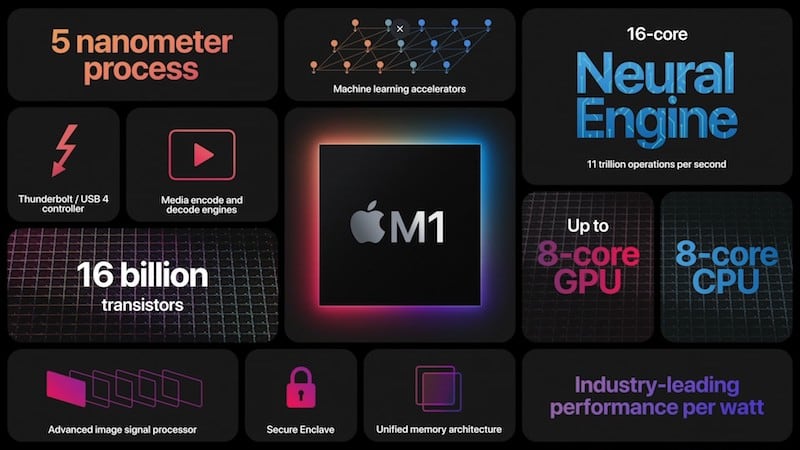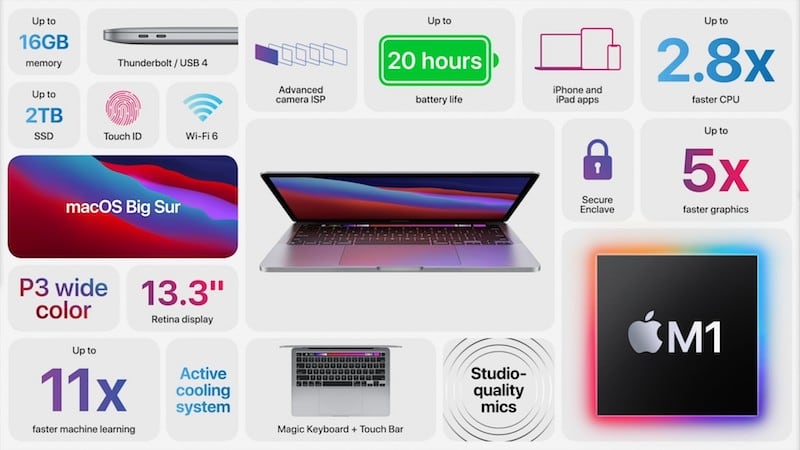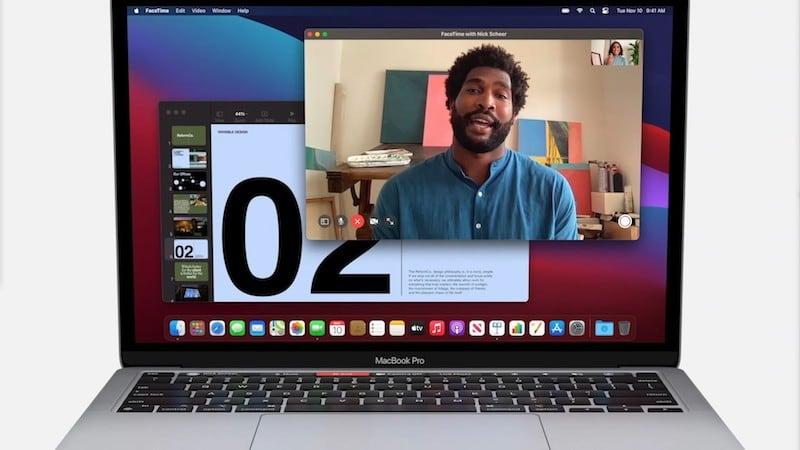After 15 years, the tech industry is getting a massive upgrade. The Apple Silicon Macs are finally here, and we couldn’t be more excited. These Macs are setting a benchmark in the world of computing and paving the way for Apple to be a more self-sufficient brand. Will this work in Apple’s favor? Keep on reading to find out more.

When Apple announced the iPhone 12 series last month and all the cool things it can do with 5G, Ceramic Shield, and MagSafe, it seemed like that would be the best from Apple this year. But, hey, there’s still One More Thing left to add to the amazing lineup in 2020. Announced back at WWDC 2020, Apple finally set a launch date for its own Apple-Silicon-backed Mac series. If you’ve been a MacBook user forever, you’ll know that this was an announcement most of us Mac lovers were waiting for. From a brand with tremendous success using its own custom chips in the mobile world, such a transition for laptops—and, eventually, desktops—was inevitable. But, when you think of such a major transition in the world of Macs, you may also be somewhat skeptical about its success.

Apple Silicon Macs instantly wake
See Also: Best Macbook Pro accessories to buy in 2020
Nevertheless, this is possibly one of the biggest updates in the tech industry ever since Apple switched to Intel x86 chips back in 2005. Is this move a smart way to make one of Apple’s most popular products, the MacBook, more self-sufficient?
Tim Cook, Apple’s CEO, stated this at the WWDC 2020 keynote.
From the beginning, the Mac has always embraced big changes to stay at the forefront of personal computing. Today we’re announcing our transition to Apple Silicon, making this a historic day for the Mac. With its powerful features and industry-leading performance, Apple Silicon will make the Mac stronger and more capable than ever. I’ve never been more excited about the future of the Mac.
Why did Apple switch to Apple Silicon?
Ever since the launch of its first product back in 1984, Apple has focused on providing fast performance through compact product designs. In 2005, Apple switched from the IBM PowerPC G5 to the Intel x86 because the PowerPC failed to deliver the 3 GHz Power Mac G5 within 12 months. Clearly, Apple was not ready to compromise on speed and performance even then.
Fast forward to 2020, and the situation is somewhat similar. If you look at all the discussions and updates from Apple over the past few years, they point to two possible reasons for this switch.
1. Apple prefers its own technology
With the iPhone, iPad, and Apple Watch all using its own technology, Apple clearly prefers to rely on itself. So it was inevitable that Apple would come up with a new line of Macs that are solely run by its own ARM-based Silicon processors.
- The new M1 chip comes with faster performance and better battery life
2. Apple has a not-so-fast-tracked relationship with Intel
Other than Apple’s own ambition, one of the other factors that triggered the switch was the constant chip-development delays at Intel. This was first experienced with Intel’s abnormally bad Skylake bug 2016. However, it was the only incident that could have been a possible trigger. Later in 2016, Intel promised to deliver its 10 nm CPUs by Q3 of that year. These chips would pack more power in compact designs—a great benefit for companies like Apple that want small, seamless products. The chips would draw less heat from the CPU, thereby making them a great option for laptops. Unfortunately, Intel took more than three years to ship those chips out. In fact, even at the last announcement, Intel stated no release date for the 10 nm desktop chips.
The 2016 Apple MacBook Pro was way thinner than before, but its thermal capacity was a disaster. Apple may have designed these laptops expecting the 10 nm chips to control heat dissipation. But, due to constant delays, the lineups over the past few years have failed in this way. And these delays might have accelerated Apple’s switch to an in-house processor.
What are the benefits of the Apple Silicon transition?
The new transition focuses on a lot of important factors that make your new Apple Silicon Macs so much faster and better at combatting the heat throttle. They will also add advanced power management, a Secure Enclave, and a high-performing GPU to every Mac. This change focuses on better performance and using less battery power in new Macs made with Apple chips. And Mac-specific SoCs will give unique features to Mac but provide common architecture across product lines.
Apple Silicon
Other than this, the Apple Silicon transition also provides these competitive advantages.
- Apple won’t have to depend on other Original Equipment Manufacturers (OEMs) for the same chips. If you look at how Apple’s volume impacted Intel, it’s not even close to what other tech giants like Dell and Lenovo have. So, naturally, hardware manufacturing is a lower priority to it than it is for the others.
- Apple will not have to negotiate its desired features with OEMs based on what other tech giants are doing. Apple can simply do what it wants with its own Silicon chips.
- Thanks to the in-house switch, iOS apps will run natively on this hardware. There’s no translation required. And Apple vouches for seamless connectivity across devices, so they will work faster than ever.
- Vertical control of both hardware and software will give Apple the power to do anything with its devices. No other computer manufacturer has done this. Whether it’s about launching affordable Macs or going for even more compact designs with both laptops and desktops, it’s now in Apple’s hands.
Are there any disadvantages of the Apple Silicon transition?
As of now, the most important factor to consider is that Apple is stepping into this game for the first time, and it’s trying to make the performance of these Silicon chips compete with Intel. That might cause a few hiccups and bottlenecks in the beginning as with most product launches. However, this should not be a long-term issue because the transition will fall into place over time.
Another factor worth considering is Apple’s compatibility with Windows. One of the benefits of Apple’s move to Intel back in 2006 was that it meant that Mac users could run Windows on the Mac. This opened the Mac up to people who were hesitant about leaving Windows behind. But with Apple Silicon, this could be an issue.

The new M1 chip frame
However, these are all speculations. They come with any new product launch. Apple’s been leading the smartphone and tablet industry with its ARM-based chips. Now, with the transition to Macs, we hope it gets even better.
Apple Silicon M1 specs—how cool is it?
Apple Silicon has been at the heart of the iPhone, iPad, and Apple Watch. But, with this transition, the M1 chip ushers in a whole new era for the Mac. The primary focus of this chip is power efficiency while maintaining performance. Until now, a Mac needed multiple chips to perform at its best. But M1 does it all through a uniform memory architecture. This dramatically improves performance and power efficiency. It’s the first personal computing chip built using industry-leading five-nanometer technology. It comes with four high-performance single-thread cores that deliver similar performance to the current Macs but with low power consumption. In fact, the M1 will give about three times better performance per watt when compared to previous Mac chips.

The new M1 chip at a glance
The M1 also comes with integrated graphics to give you two times better performance than other PC chips by using just a third of the power. And the M1 excels in machine learning by performing 11 trillion operations per second.
In order to make the Silicon Macs work even better, macOS Big Sur is now customized specifically for the M1-chip-based Apple Silicon Macs. This makes processes like launching apps or any other daily activity you do on your Mac even more instantaneous.

M1 chip CPU performance
When it comes to security, the M1 comes with a hardware-verified secure booth, automatic encryption, and more.
These are the apps you get in Apple Silicon.
- Universal apps: This is one app for all of your Macs that you can download from the App Store.
- Rosetta 2: Translation software for nonuniversal apps.
- iOS and iPad apps on your Mac: Yes, that’s finally happening.

The new M1 GPU performance
All Apple apps, including Final Cut Pro and Logic Pro, will run natively on ARM. What’s more, Microsoft and Adobe are working on running on Apple Silicon. Because macOS Big Sur will include Rosetta 2, it will automatically translate Intel apps to Apple Silicon at the time of install.
Apple M1 Benchmark
The GeekBench scores for the new Apple M1 Silicon chip-based Macs are said to be 1687 (single-core score) and 7433 (multi-core score). According to the benchmark, the M1 also has a 3.2GHz base frequency. In fact, it is seen that this chip is outperforming all existing iOS devices.
When it comes to other Macs, the comparison is a bit different. As reported on MacRumors, “In comparison to Macs, the single-core performance is better than any other available Mac, and the multi-core performance beats out all of the 2019 16-inch MacBook Pro models, including the 10th-generation high-end 2.4GHz Intel Core i9 model. That high-end 16-inch MacBook Pro earned a single-core score of 1096 and a multi-core score of 6870.”
Apple M1 Multi-Core Benchmark
Apple M1 Single-Core Benchmark
Apple M1 software compatibility
– macOS Big Sur will be delivering a massive boost in performance, astonishing battery life, and even stronger security protections in M1.
– Just like iPhone and iPad, the Mac now instantly wakes from sleep.
– Browsing with Safari — which is already the world’s fastest browser — is now up to 1.5x speedier at running JavaScript and nearly 2x more responsive.
– All of Apple’s Mac software is now Universal and runs natively on M1 systems.
– Existing Mac apps that have not been updated to Universal will run seamlessly with Apple’s Rosetta 2 technology.
– And iPhone and iPad apps can now run directly on the Mac.
– The foundations of Big Sur are optimized to unlock the power of M1, including developer technologies from Metal for graphics to Core ML for machine learning.
Which models have Apple Silicon M1?
The wait is finally over, and we have the models from Apple that use the brand new M1 chip.
The new MacBook Air with M1 Apple Silicon
The MacBook Air redefines what a thinner notebook can do. With eight incredibly powerful cores, the CPU in the new MacBook Air with M1 has three times faster performance than before. This means it can manage huge raw libraries in Lightroom and offer five times faster graphics performance. It provides immersive gaming with significantly higher frame rates. The new Air is up to three times faster than the Windows laptops of its class. With 16 cores, machine learning is nine times faster than the previous Air. Even storage gets a boost with two times faster SSDs. The new Air gives you that performance with a silent design. It also provides up to 15 hours of wireless web battery life and 18 hours of video playback. With M1 and Big Sur, the MacBook Air starts at $999.

The new MacBook Air with M1 at a glance
The new Mac mini with M1 Apple Silicon
It delivers a Mac desktop experience in an incredibly small form factor. M1 comes to Mac mini and gives it up to three times faster CPU performance. The eight-core GPU gives the mini a sixfold increase in graphics performance. If you compare the Mac mini to the top-selling PC desktop in its price range, it’s one-tenth the size with five times the performance. It starts at just $699.

New Mac mini with M1 at a glance

New Mac mini ports
The new 13-inch MacBook Pro with M1 Apple Silicon
With M1, the 13-inch MacBook Pro becomes way more powerful and way more Pro. It comes with nearly eight times the performance of the previous MacBook Pro. And it’s up to three times faster than the best-selling Windows laptop in its class. The new MacBook Pro can play back 8K ProRes video in Resolve without dropping a single frame. It comes with 17 hours of wireless web browsing and 20 hours of video playback battery life. The studio-quality mic gives you super clean audio during conference calls. With Big Sur and the M1 chip at the heart of it, the new MacBook Pro is still just $1,299.

The new MacBook Pro with M1 at a glance
When will the new Silicon Macs be available?
All three of the products will be available to order starting today, and shipping begins next week. The transition to Apple Silicon will take time, and the company is predicting a two-year timeline for the entire transition.
So does that mean you should wait? Not if you want to experiment with the new M1 chip right away. But, if you’re expecting all of your favorite apps to be available in the Apple App store for the new MacBooks right away, you might have to wait it out.

Big Sur in M1 chip MacBook Pro
Apple Silicon Macs are not just another MacBook series. They represent a breakthrough in the world of tech as Apple moves toward entirely in-house hardware. It’s been a tremendous year for the company, and, being Apple fans, we couldn’t have asked for more. What’s your take on the new Silicon Macs? Would you buy them? Share with us in the comments below.








